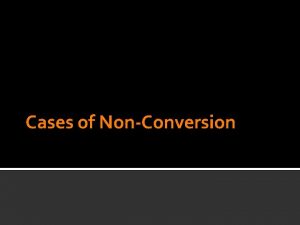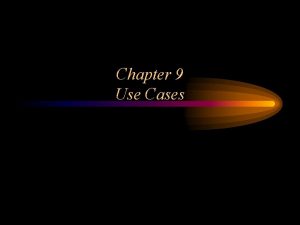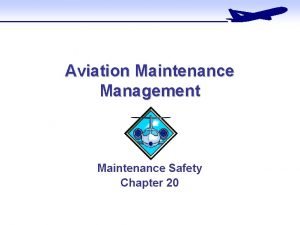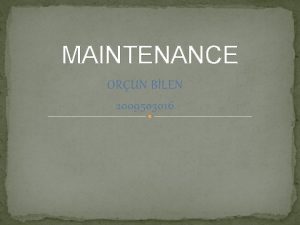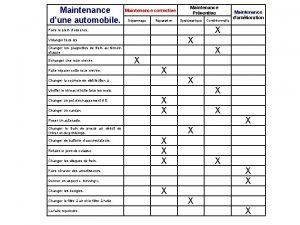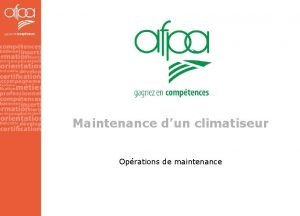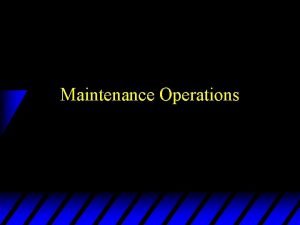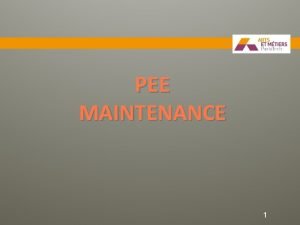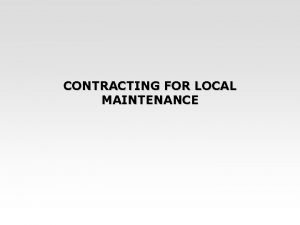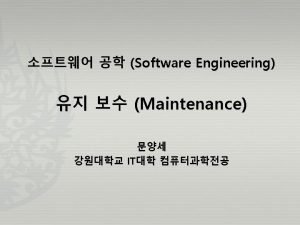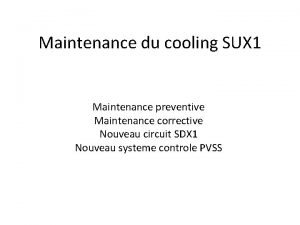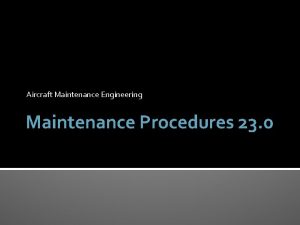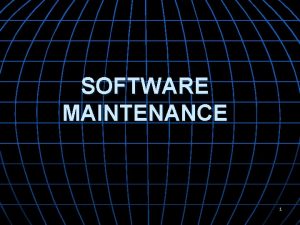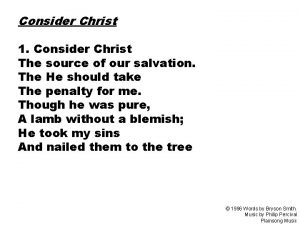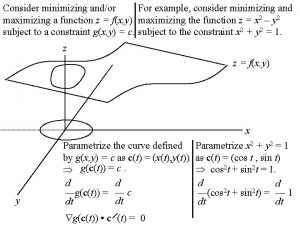Experience Maintenance Why Experience Maintenance Consider the cases
































- Slides: 32

Experience Maintenance

Why Experience Maintenance? Consider the cases - when a highly skilled employee leaves, he “takes his experience” with him - when new employees are inducted, they have to be trained manually - when the current project at hand is very similar to one that has been done before – do we need to do it all over again? Solution : Experience Maintenance!

What is Experience Maintenance Formally, it is defined as …‘the acquisition, sharing and use of knowledge within organizations, including learning processes and management information systems’

What is Experience Maintenance In other words It is an information system that aids knowledge workers to create, integrate and reuse knowledge in an organization.

What is the role of knowledge in IS, and IS development? Requirements Analysis Systems Design System Implementation ERD Forms Spec Architecture Update Marketing Authorize Credit Tables Order Entry Bill Customer VB Code Schedule Delivery Inventory Knowledge about world Refer Experience Base Reuse applicable experience Update Experience Base VC++ Code

Types of Experience Explicit Ø Ø You can communicate Easy to formalize Savable on different media disembodied Implicit Ø hard to communicate Hard to formalize Saved in brain Ø embodied Ø Ø Experience Maintenance System converts implicit knowledge into explicit

Data to Knowledge Very Valuable!

Experience Maintenance Cycle Collect Identify Classify Create Organize/ Store Use/Exploit Access Share/ Disseminate

Why Experience Maintenance? ü Product lifecycle becomes shorter ü Streamline operations and reduce costs by eliminating redundant or unnecessary processes ü Reduce training time ü Foster innovation by encouraging the free flow of ideas ü Improve customer service by streamlining response time ü Boost revenues by getting products and services to market faster ü Enhance employee retention rates by recognizing the value of employees' knowledge and rewarding them for it

Main Areas of Experience Maintenance Ø Capturing knowledge Ø Storing knowledge Ø Creating knowledge Ø Distributing knowledge Ø Sharing knowledge Ø Using knowledge Transfer knowledge from the individual to the collective realm

What does an Experience Management System Share ü Skills ü Experiences ü Reflections ü Lessons ü Memoirs ü Technical advice ü Experts intuition ü Case studies ü Best practices ü Methodologies

INRECA supports the development of experience management applications by an experience management approach itself. ü Targeted at industrial experience management applications development ü Based on software engineering techniques and using these techniques to build/maintain experience management applications ü Applies Case-Based Reasoning to experience management application development

INRECA Company 1 Company 2 Company 3 Company 4 … Company N … EMA 1 EMA 2 EMA 3 EMA 4 EMA N

INRECA Product 1 Product 2 Company 1 EMA 1 Product 3. . . Product N

INRECA Methodology The INRECA Methodology (contd. ) - Has an experience base containing specific experience on how to build experience management applications - This experience base is represented in the form of linked HTML documents. - ü ü The structure of these documents and the linking structure is derived from software process modeling Using this form (textual based) of representation results in: Increased flexibility Decreased accuracy

INRECA Process Model The INRECA Process Model has 3 main components: 1. Process – Describes what should be done 2. Method – Describes how to do it 3. Product – Describes what is output of the process Input Product Complex Method Output Product Process Simple Method

INRECA Experience Base is organized on 3 levels of abstraction: 1. Common Generic Level The processes, products and methods in this level are common across a wide spectrum of different experience management applications. 2. Cookbook Level The processes, products and methods in this level are tailored for a particular class of applications (e. g. help desk, technical maintenance, product catalog). 3. Specific Project Level This level describes experience in the context of a single, particular project that has been carried out.

INRECA Experience Base Common Generic Level Cookbook level Specific Project Level Building blocks & general purpose approach Recipe 1 Recipe 2 … Recipe N … App. 1 App. 2 App. 3 App. N

INRECA Processes The INRECA methodology adapts techniques used in software engineering. As a result of this, the INRECA process modeling is very much similar to software process modeling. Like in software process modeling, the processes in INRECA are divided into 3 types: § § § Technical processes Organizational processes Managerial processes

INRECA Processes § Technical processes These describe the development of the system and the required documentation. e. g. requirement analysis, testing, system design. § Organizational processes These address those parts of the organization’s business process in which the newly developed system will be embedded. e. g. in building a help-desk system, organizational processes could be training help-desk personnel, updating help-desk system

INRECA Processes § Managerial processes The primary goal of these is to provide services for enacting the technical and the organizational processes. e. g. project planning, quality assurance and monitoring

INRECA Descriptions The INRECA methodology contains descriptions of each of the processes, methods and products. There are 2 kinds of descriptions Generic Descriptions These describe the products, methods and processes in a way that is independent of a specific development project e. g. for a GUI development project, generic description would specify the general information the GUI should contain Specific Descriptions These elaborate processes, methods and products for a particular development project. e. g. for a GUI development project, specific description would be the GUI tool used, client GUI specification etc.

INRECA Descriptions These descriptions are stored as HTML documents and the documents are linked hierarchically. There are totally 8 kinds of documents in the INRECA experience base 1. 2. 3. 4. 5. 6. 7. 8. Generic Process Description Sheet Product Description Sheet Simple Method Description Sheet Complex Method Description Sheet Specific Process Description Sheet Product Description Sheet Simple Method Description Sheet Complex Method Description Sheet

INRECA Process Description Sheet

INRECA Reuse The INRECA Reuse Procedure 1. Characterize New 2. Project 2. Recipe Available? 3 a. Analyze Process From Recipe 3 b. Select Similar Specific Project 3 c. Develop Project Plan by Reuse 4 a. Analyze Process From Common Generic Level 4 b. Develop Project Plan by Combining Processes 5. Enact Project & Record Project Trace

INRECA Reuse 1. Identify the application area of the experience management project. 2. Identify if an appropriate recipe is available. 3. a) An appropriate recipe is available. The process model contained in this recipe must be analyzed. b) Analyze project descriptions on specific project level. If a match is found, the reusability is analyzed. c) Develop a project plan for the new project based on the process model from the selected recipe.

INRECA Reuse 4. a) The set of processes described at the generic level are analyzed in the light of the new project to identify those processes that are important. b) Based on the selected processes, a new project plan must be assembled. 5. Execute the project by enacting the project plan. Document the experience during the enactment of the project.

Maintaining INRECA The INRECA Maintenance Procedure 6. Analyze project trace 7. Add specific project 8. Create or update Recipe 9. Update Generic Level

Maintaining INRECA 6. Analyze all the information collected about the project and identify the actually enacted processes. 7. Document the project by creating a specific project description and add to the specific project level of INRECA experience base. 8. If the project falls under an existing recipe, update the recipe if deviations from the original plan have been noticed. Else, create a new recipe. 9. Any new generic processes, methods or products identified in the above steps that are of generic interest are added to the common generic level.

Open issues in experience maintenance Ø Expressiveness of modelling concepts • Knowledge conversion, learning • Authority, ownership, location • Viewpoints, scenarios, time, dynamics Ø Analysis and design techniques § Qualitative and quantitative reasoning Ø Tools, visualization Ø Reusable design knowledge, patterns Ø Usage methodologies

Some Companies Using Experience Maintenance Systems Benetton General Electric National Bicycle Ritz Carlton Agro Corp Frito-Lay Dow Chemical Outokumppu Skandia Switzerland Steelcase 3 M Analog Devices Boeing Buckman Labs Chaparral Steel Ford Motor Co Hewlett-Packard Oticon WM-data Mc. Kinsey Bain & Co Chevron British Petroleum PLS-Consult Skandia AFS Telia Celemi Skandia WM-data Buckman Labs IBM Pfizer WM-data Affaersvaerlden Hewlett-Packard Honda PLS-Consult Xerox Matsushita Netscape

Summary What we’ve seen about experience maintenance… ü ü ü What is it? Why do wee need it? What does it do? How does an organization benefit from it? The working of INRECA – an experience maintenance/development system
 Criminal cases vs civil cases
Criminal cases vs civil cases Why why why why
Why why why why Dont ask why why why
Dont ask why why why Imprint definition psychology
Imprint definition psychology Early experience vs. later experience
Early experience vs. later experience Direct experience vs indirect experience
Direct experience vs indirect experience Hình ảnh bộ gõ cơ thể búng tay
Hình ảnh bộ gõ cơ thể búng tay Slidetodoc
Slidetodoc Bổ thể
Bổ thể Tỉ lệ cơ thể trẻ em
Tỉ lệ cơ thể trẻ em Voi kéo gỗ như thế nào
Voi kéo gỗ như thế nào Tư thế worms-breton
Tư thế worms-breton Alleluia hat len nguoi oi
Alleluia hat len nguoi oi Môn thể thao bắt đầu bằng từ chạy
Môn thể thao bắt đầu bằng từ chạy Thế nào là hệ số cao nhất
Thế nào là hệ số cao nhất Các châu lục và đại dương trên thế giới
Các châu lục và đại dương trên thế giới Công của trọng lực
Công của trọng lực Trời xanh đây là của chúng ta thể thơ
Trời xanh đây là của chúng ta thể thơ Mật thư tọa độ 5x5
Mật thư tọa độ 5x5 101012 bằng
101012 bằng Phản ứng thế ankan
Phản ứng thế ankan Các châu lục và đại dương trên thế giới
Các châu lục và đại dương trên thế giới Thể thơ truyền thống
Thể thơ truyền thống Quá trình desamine hóa có thể tạo ra
Quá trình desamine hóa có thể tạo ra Một số thể thơ truyền thống
Một số thể thơ truyền thống Cái miệng nó xinh thế
Cái miệng nó xinh thế Vẽ hình chiếu vuông góc của vật thể sau
Vẽ hình chiếu vuông góc của vật thể sau Biện pháp chống mỏi cơ
Biện pháp chống mỏi cơ đặc điểm cơ thể của người tối cổ
đặc điểm cơ thể của người tối cổ V cc
V cc Vẽ hình chiếu đứng bằng cạnh của vật thể
Vẽ hình chiếu đứng bằng cạnh của vật thể Fecboak
Fecboak Thẻ vin
Thẻ vin

































